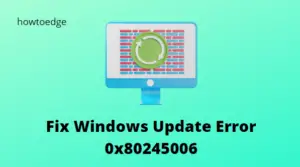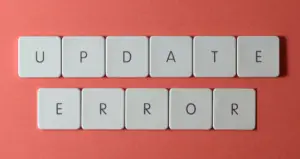Windows Update is an essential feature of any Windows operating system. It helps keep your system secure by ensuring that you are up-to-date with the latest security patches and bug fixes. Unfortunately, sometimes the update process can fail and you are presented with an error code such as 0x8024002e. This article will provide a few possible solutions to help you fix this issue.

How to Fix Windows Update Error 0x8024002e
To fix Windows Update Error 0x8024002e, follow the below suggestions:
1] Run the Windows Update Troubleshooter
The first thing you should do when you encounter this error is to run the Windows Update Troubleshooter. This tool will scan your system for errors and can help you identify a potential cause for the issue.
- Press the Windows + I keyboard shortcut to open the Settings app.
- Click on System > Troubleshoot > Other troubleshooters.

- Scroll to Windows Update, then click the Run option.
The troubleshooter will begin to scan for problems with Windows Update. Please wait for it to be complete. If the troubleshooter detects any problems, it will display them and offer solutions.
Follow the on-screen instructions to fix the issue. Once the troubleshooter has finished, restart your computer and try to update Windows again.
2] Restart Some Core Services
If the troubleshooter doesn’t detect any problems or is unable to fix the issue, check if all the essential services are running on your computer. Here is how to do it:
- Press the Windows key + R to open the Run dialog box.
- Type services.msc and press Enter.
- Scroll through the list of services and look for Background Intelligent Transfer Service (BITS).

- Once you find the service, right-click on it and select Restart or Stop and then Start.
- Similarly, find Windows Update and Windows Installer and restart them.
- Close the Services window and try to update Windows again.
3] Run the System File Checker Tool
The System File Checker (SFC) tool can be used to scan and repair corrupted or missing system files that may be causing the Windows Update error 0x8024002e. Here’s how to run the SFC tool:
- Press the Windows + X and select Terminal (Admin).

- Type sfc /scannow in the Command Prompt window and press Enter.
The SFC tool will begin scanning all protected system files. This process may take several minutes to complete. If the SFC tool finds any corrupted or missing files, it will automatically repair them. Once the scan is completed, restart your computer and try to update Windows again.
4] Run the DISM Command
If your system files are too damaged, they may not repair properly. In this case, you may have to try running the DISM tool to repair the Windows operating system and fix Windows Update error 0x8024002e. Here’s how to run the DISM command:
- Run Command Prompt as an administrator.
- Type the below command in the command prompt window and press Enter after typing each one.

Dism /Online /Cleanup-Image /CheckHealth Dism /Online /Cleanup-Image /ScanHealth Dism /Online /Cleanup-Image /RestoreHealth
Running the above command will scan the system for any corruption. If the scan detects any problems, it will attempt to repair the component store. Wait for the command to complete, which may take several minutes. Once the DISM command is finished, restart your computer and try to update Windows again.
5] Rename the SoftwareDistribution Folder
In case you’re still experiencing this issue, you might want to rename the “Software Distribution” folder. This will clear the Windows Update cache and reset the update components. The steps are as follows:
- Right-click on Start and select Run.
- Type “services.msc” in the dialog box and press Enter.
- Locate the Windows Update service in the list and double-click on it.
- Click on the Stop button to stop the service.
- Close the Services window and open the Run dialog box again.
- Type C:\Windows\SoftwareDistribution in the text box and press Enter.

- Rename the SoftwareDistribution folder to SoftwareDistribution.old.
- Again go to the Services window.
- Right-click on Windows Update and select Start to start the service.
- Now close the Services window and try updating Windows again.
Renaming the SoftwareDistribution folder will delete the Windows Update history, which means it may take longer for Windows to check for updates in the future. Also, make sure you have administrative access and do not rename any other folders while you are renaming this.
6] Perform a Clean Boot
If none of the methods above work, you may need to troubleshoot your computer in a clean boot state. This will help you determine if any third-party programs are conflicting with Windows Update that might be causing the error. Here’s how to perform a clean boot:
- Click on Start and search for System Configuration.
- Select the result at the top of the list.
- In the System Configuration window, click on the Services tab.
- Check the box next to Hide all Microsoft services.

- Click on Disable all.

- Now go to the Startup tab and click on Open Task Manager.
- In the Task Manager, select each startup item and click on Disable.
- Close the Task Manager window and click OK in the System Configuration window.
- Restart your computer and try updating Windows again.
It’s important to note that after doing a clean boot, you need to go back into MSConfig and under the Services tab, and the Startup tab, re-enable the services and startup items that you’ve disabled in previous steps. Also, it’s important to check the services you’ve disabled, some of them may be essential for your computer to function properly.
Frequently Asked Questions
What Causes Windows Update Error 0x8024002e?
Windows Update Error 0x8024002e can be caused by a number of different issues, including incorrect settings, a corrupted Windows Update component, or a blocked internet connection. It is important to identify the cause of this error before attempting any solutions.
What happens if you don’t update Windows?
If you don’t update Windows, your system may become vulnerable to security threats and malicious software. Not updating can also cause your computer to run slower and experience issues with features and programs. It is important to keep your system up-to-date in order to protect it from potential threats.



